Professional Project on Employee Absenteeism in Healthcare
VerifiedAdded on 2020/05/16
|24
|4858
|436
Project
AI Summary
This project examines employee absenteeism within the healthcare industry, focusing on its impact and management strategies. It begins with an executive summary and table of contents, followed by an introduction outlining the research aims, objectives, and questions. A literature review explores the rate of employee absenteeism, its causes (including mental stress and workplace strategies), and its effects on healthcare outcomes, such as reduced productivity and increased costs. The paper then outlines the research methodology, including the chosen research philosophy (positivism), approach (deductive), and data collection methods (secondary). The project also includes findings, analysis, discussion, and conclusions, along with recommendations and references. The project aims to identify reasons for disengagement, the effects of absenteeism, and strategies for improvement, such as training and reward functions. The research uses secondary data to analyze employee absence in healthcare and proposes strategies for mitigating absenteeism and improving overall industry performance.
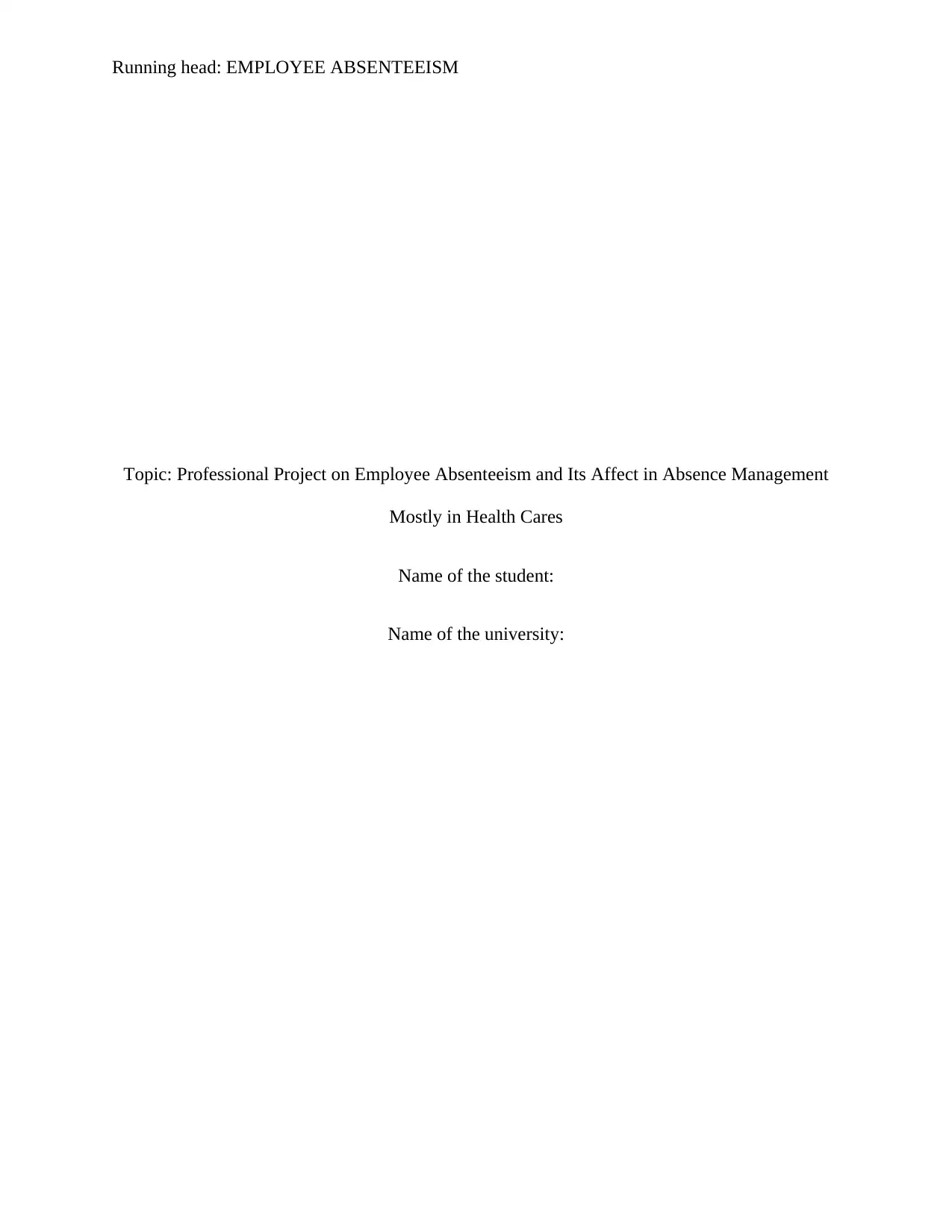
Running head: EMPLOYEE ABSENTEEISM
Topic: Professional Project on Employee Absenteeism and Its Affect in Absence Management
Mostly in Health Cares
Name of the student:
Name of the university:
Topic: Professional Project on Employee Absenteeism and Its Affect in Absence Management
Mostly in Health Cares
Name of the student:
Name of the university:
Paraphrase This Document
Need a fresh take? Get an instant paraphrase of this document with our AI Paraphraser
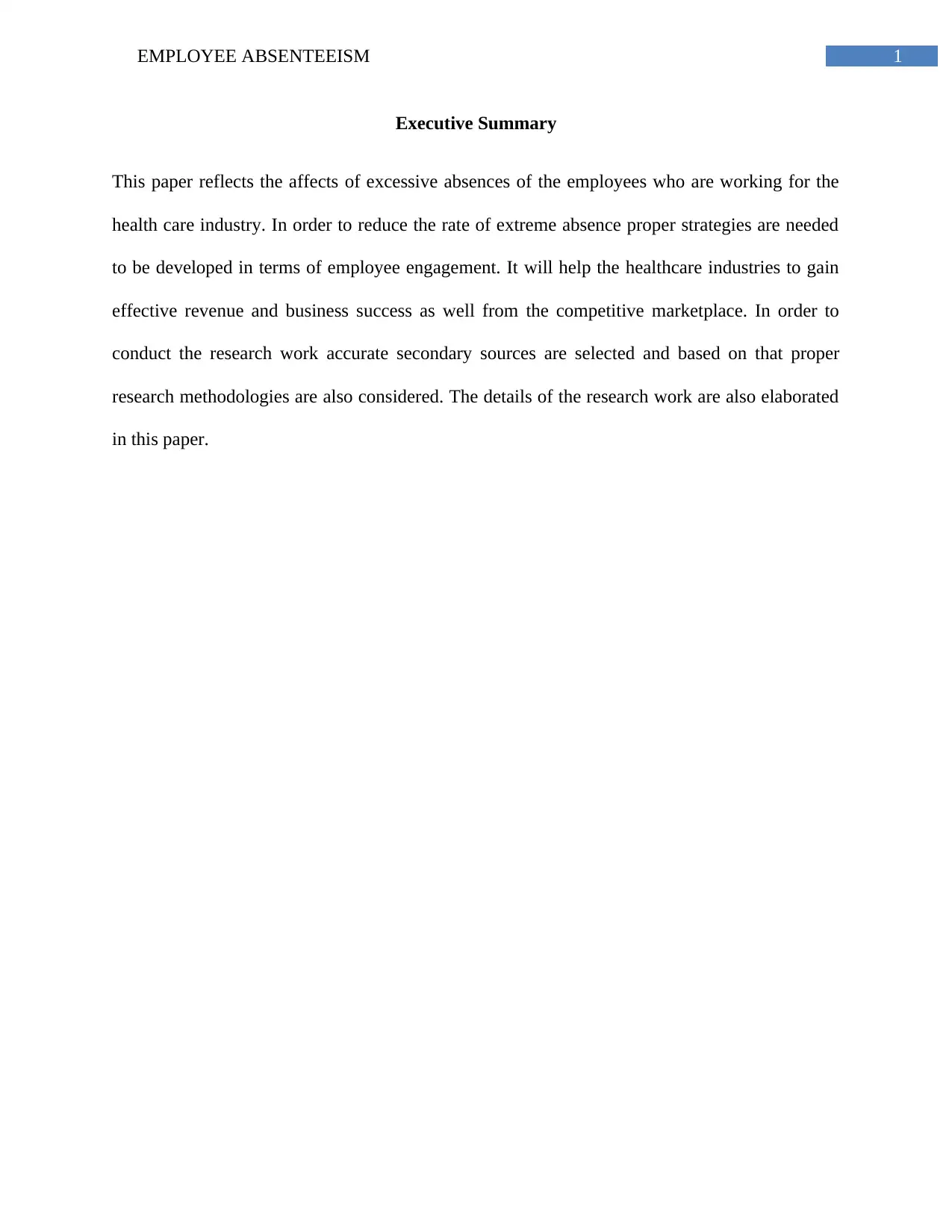
1EMPLOYEE ABSENTEEISM
Executive Summary
This paper reflects the affects of excessive absences of the employees who are working for the
health care industry. In order to reduce the rate of extreme absence proper strategies are needed
to be developed in terms of employee engagement. It will help the healthcare industries to gain
effective revenue and business success as well from the competitive marketplace. In order to
conduct the research work accurate secondary sources are selected and based on that proper
research methodologies are also considered. The details of the research work are also elaborated
in this paper.
Executive Summary
This paper reflects the affects of excessive absences of the employees who are working for the
health care industry. In order to reduce the rate of extreme absence proper strategies are needed
to be developed in terms of employee engagement. It will help the healthcare industries to gain
effective revenue and business success as well from the competitive marketplace. In order to
conduct the research work accurate secondary sources are selected and based on that proper
research methodologies are also considered. The details of the research work are also elaborated
in this paper.
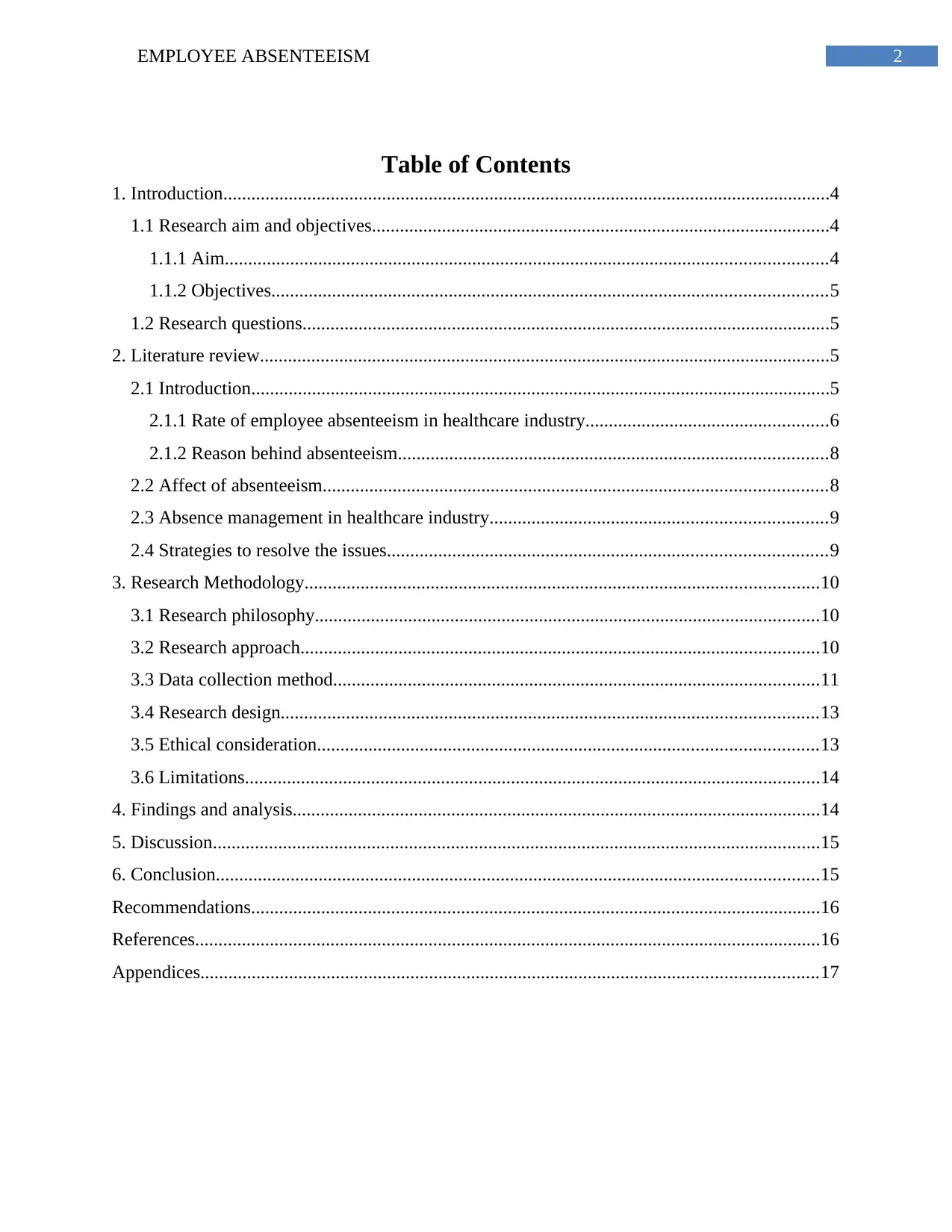
2EMPLOYEE ABSENTEEISM
Table of Contents
1. Introduction..................................................................................................................................4
1.1 Research aim and objectives..................................................................................................4
1.1.1 Aim.................................................................................................................................4
1.1.2 Objectives.......................................................................................................................5
1.2 Research questions.................................................................................................................5
2. Literature review..........................................................................................................................5
2.1 Introduction............................................................................................................................5
2.1.1 Rate of employee absenteeism in healthcare industry....................................................6
2.1.2 Reason behind absenteeism............................................................................................8
2.2 Affect of absenteeism............................................................................................................8
2.3 Absence management in healthcare industry........................................................................9
2.4 Strategies to resolve the issues..............................................................................................9
3. Research Methodology..............................................................................................................10
3.1 Research philosophy............................................................................................................10
3.2 Research approach...............................................................................................................10
3.3 Data collection method........................................................................................................11
3.4 Research design...................................................................................................................13
3.5 Ethical consideration...........................................................................................................13
3.6 Limitations...........................................................................................................................14
4. Findings and analysis.................................................................................................................14
5. Discussion..................................................................................................................................15
6. Conclusion.................................................................................................................................15
Recommendations..........................................................................................................................16
References......................................................................................................................................16
Appendices....................................................................................................................................17
Table of Contents
1. Introduction..................................................................................................................................4
1.1 Research aim and objectives..................................................................................................4
1.1.1 Aim.................................................................................................................................4
1.1.2 Objectives.......................................................................................................................5
1.2 Research questions.................................................................................................................5
2. Literature review..........................................................................................................................5
2.1 Introduction............................................................................................................................5
2.1.1 Rate of employee absenteeism in healthcare industry....................................................6
2.1.2 Reason behind absenteeism............................................................................................8
2.2 Affect of absenteeism............................................................................................................8
2.3 Absence management in healthcare industry........................................................................9
2.4 Strategies to resolve the issues..............................................................................................9
3. Research Methodology..............................................................................................................10
3.1 Research philosophy............................................................................................................10
3.2 Research approach...............................................................................................................10
3.3 Data collection method........................................................................................................11
3.4 Research design...................................................................................................................13
3.5 Ethical consideration...........................................................................................................13
3.6 Limitations...........................................................................................................................14
4. Findings and analysis.................................................................................................................14
5. Discussion..................................................................................................................................15
6. Conclusion.................................................................................................................................15
Recommendations..........................................................................................................................16
References......................................................................................................................................16
Appendices....................................................................................................................................17
⊘ This is a preview!⊘
Do you want full access?
Subscribe today to unlock all pages.

Trusted by 1+ million students worldwide
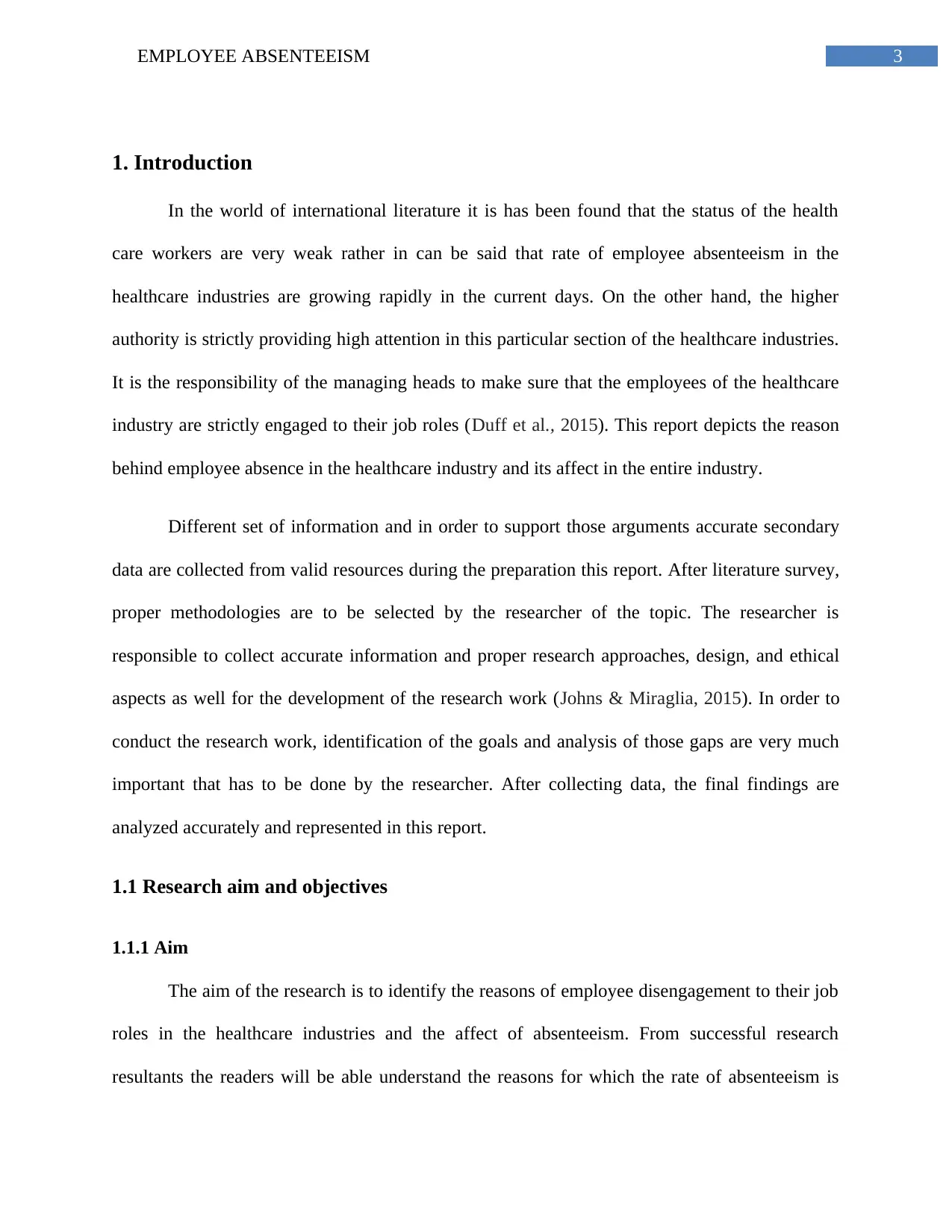
3EMPLOYEE ABSENTEEISM
1. Introduction
In the world of international literature it is has been found that the status of the health
care workers are very weak rather in can be said that rate of employee absenteeism in the
healthcare industries are growing rapidly in the current days. On the other hand, the higher
authority is strictly providing high attention in this particular section of the healthcare industries.
It is the responsibility of the managing heads to make sure that the employees of the healthcare
industry are strictly engaged to their job roles (Duff et al., 2015). This report depicts the reason
behind employee absence in the healthcare industry and its affect in the entire industry.
Different set of information and in order to support those arguments accurate secondary
data are collected from valid resources during the preparation this report. After literature survey,
proper methodologies are to be selected by the researcher of the topic. The researcher is
responsible to collect accurate information and proper research approaches, design, and ethical
aspects as well for the development of the research work (Johns & Miraglia, 2015). In order to
conduct the research work, identification of the goals and analysis of those gaps are very much
important that has to be done by the researcher. After collecting data, the final findings are
analyzed accurately and represented in this report.
1.1 Research aim and objectives
1.1.1 Aim
The aim of the research is to identify the reasons of employee disengagement to their job
roles in the healthcare industries and the affect of absenteeism. From successful research
resultants the readers will be able understand the reasons for which the rate of absenteeism is
1. Introduction
In the world of international literature it is has been found that the status of the health
care workers are very weak rather in can be said that rate of employee absenteeism in the
healthcare industries are growing rapidly in the current days. On the other hand, the higher
authority is strictly providing high attention in this particular section of the healthcare industries.
It is the responsibility of the managing heads to make sure that the employees of the healthcare
industry are strictly engaged to their job roles (Duff et al., 2015). This report depicts the reason
behind employee absence in the healthcare industry and its affect in the entire industry.
Different set of information and in order to support those arguments accurate secondary
data are collected from valid resources during the preparation this report. After literature survey,
proper methodologies are to be selected by the researcher of the topic. The researcher is
responsible to collect accurate information and proper research approaches, design, and ethical
aspects as well for the development of the research work (Johns & Miraglia, 2015). In order to
conduct the research work, identification of the goals and analysis of those gaps are very much
important that has to be done by the researcher. After collecting data, the final findings are
analyzed accurately and represented in this report.
1.1 Research aim and objectives
1.1.1 Aim
The aim of the research is to identify the reasons of employee disengagement to their job
roles in the healthcare industries and the affect of absenteeism. From successful research
resultants the readers will be able understand the reasons for which the rate of absenteeism is
Paraphrase This Document
Need a fresh take? Get an instant paraphrase of this document with our AI Paraphraser
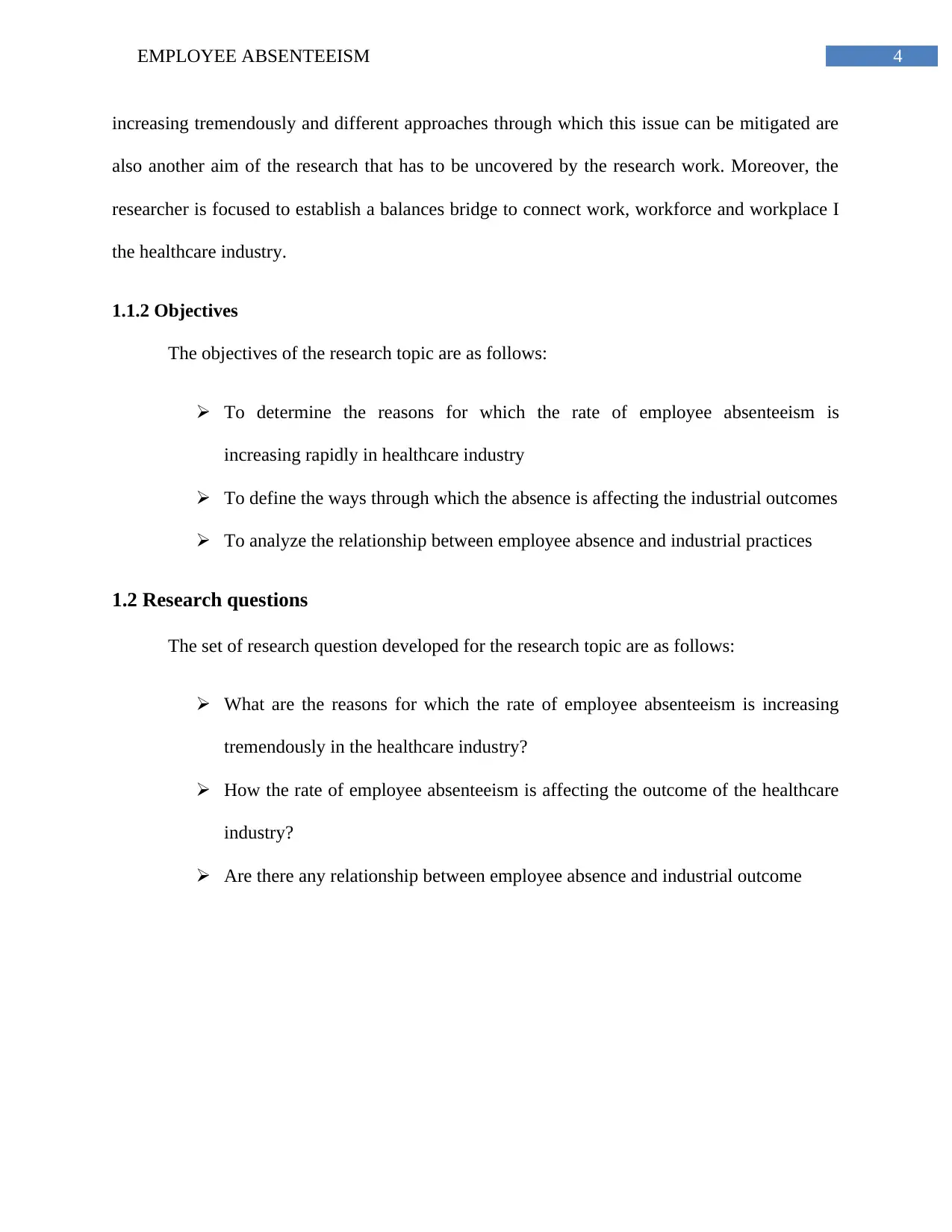
4EMPLOYEE ABSENTEEISM
increasing tremendously and different approaches through which this issue can be mitigated are
also another aim of the research that has to be uncovered by the research work. Moreover, the
researcher is focused to establish a balances bridge to connect work, workforce and workplace I
the healthcare industry.
1.1.2 Objectives
The objectives of the research topic are as follows:
To determine the reasons for which the rate of employee absenteeism is
increasing rapidly in healthcare industry
To define the ways through which the absence is affecting the industrial outcomes
To analyze the relationship between employee absence and industrial practices
1.2 Research questions
The set of research question developed for the research topic are as follows:
What are the reasons for which the rate of employee absenteeism is increasing
tremendously in the healthcare industry?
How the rate of employee absenteeism is affecting the outcome of the healthcare
industry?
Are there any relationship between employee absence and industrial outcome
increasing tremendously and different approaches through which this issue can be mitigated are
also another aim of the research that has to be uncovered by the research work. Moreover, the
researcher is focused to establish a balances bridge to connect work, workforce and workplace I
the healthcare industry.
1.1.2 Objectives
The objectives of the research topic are as follows:
To determine the reasons for which the rate of employee absenteeism is
increasing rapidly in healthcare industry
To define the ways through which the absence is affecting the industrial outcomes
To analyze the relationship between employee absence and industrial practices
1.2 Research questions
The set of research question developed for the research topic are as follows:
What are the reasons for which the rate of employee absenteeism is increasing
tremendously in the healthcare industry?
How the rate of employee absenteeism is affecting the outcome of the healthcare
industry?
Are there any relationship between employee absence and industrial outcome
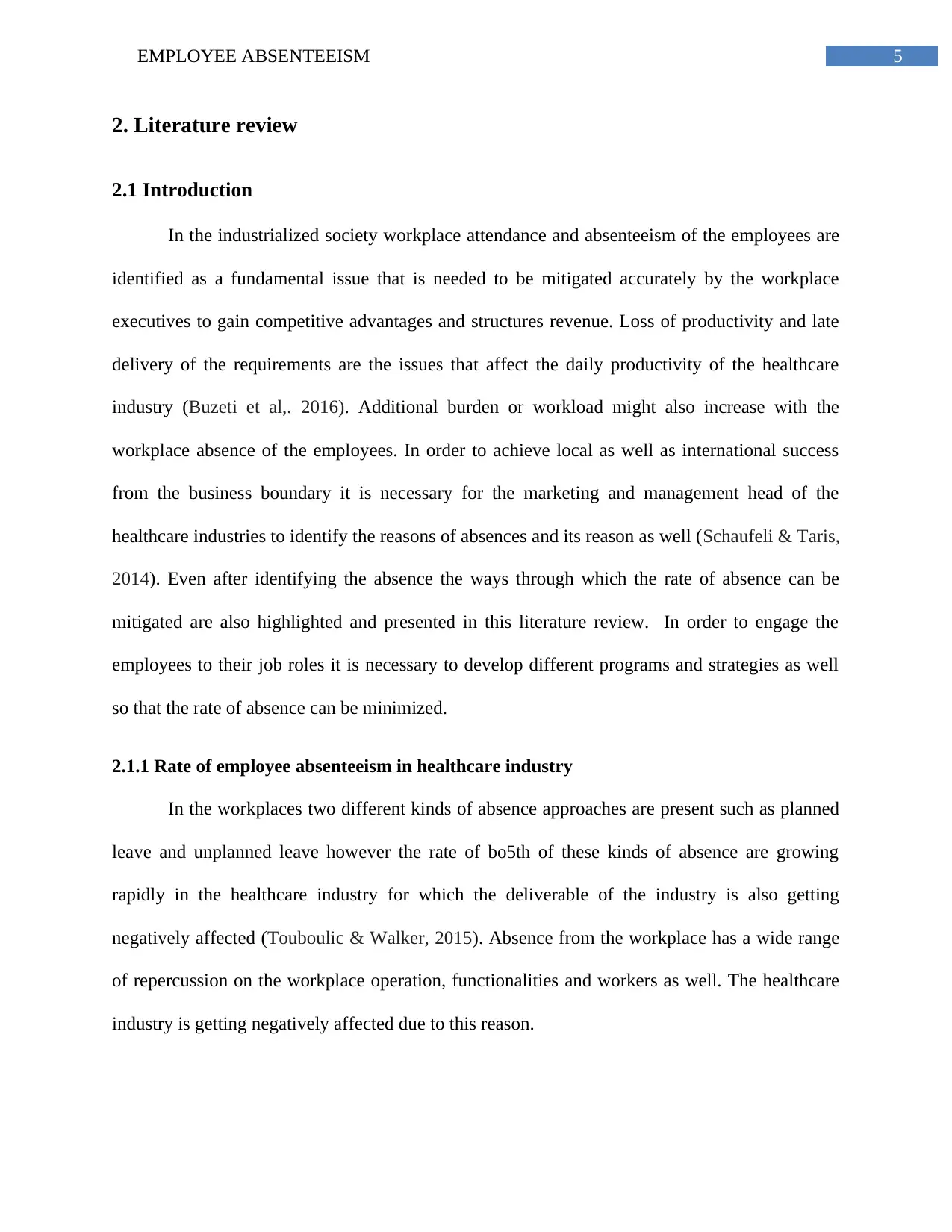
5EMPLOYEE ABSENTEEISM
2. Literature review
2.1 Introduction
In the industrialized society workplace attendance and absenteeism of the employees are
identified as a fundamental issue that is needed to be mitigated accurately by the workplace
executives to gain competitive advantages and structures revenue. Loss of productivity and late
delivery of the requirements are the issues that affect the daily productivity of the healthcare
industry (Buzeti et al,. 2016). Additional burden or workload might also increase with the
workplace absence of the employees. In order to achieve local as well as international success
from the business boundary it is necessary for the marketing and management head of the
healthcare industries to identify the reasons of absences and its reason as well (Schaufeli & Taris,
2014). Even after identifying the absence the ways through which the rate of absence can be
mitigated are also highlighted and presented in this literature review. In order to engage the
employees to their job roles it is necessary to develop different programs and strategies as well
so that the rate of absence can be minimized.
2.1.1 Rate of employee absenteeism in healthcare industry
In the workplaces two different kinds of absence approaches are present such as planned
leave and unplanned leave however the rate of bo5th of these kinds of absence are growing
rapidly in the healthcare industry for which the deliverable of the industry is also getting
negatively affected (Touboulic & Walker, 2015). Absence from the workplace has a wide range
of repercussion on the workplace operation, functionalities and workers as well. The healthcare
industry is getting negatively affected due to this reason.
2. Literature review
2.1 Introduction
In the industrialized society workplace attendance and absenteeism of the employees are
identified as a fundamental issue that is needed to be mitigated accurately by the workplace
executives to gain competitive advantages and structures revenue. Loss of productivity and late
delivery of the requirements are the issues that affect the daily productivity of the healthcare
industry (Buzeti et al,. 2016). Additional burden or workload might also increase with the
workplace absence of the employees. In order to achieve local as well as international success
from the business boundary it is necessary for the marketing and management head of the
healthcare industries to identify the reasons of absences and its reason as well (Schaufeli & Taris,
2014). Even after identifying the absence the ways through which the rate of absence can be
mitigated are also highlighted and presented in this literature review. In order to engage the
employees to their job roles it is necessary to develop different programs and strategies as well
so that the rate of absence can be minimized.
2.1.1 Rate of employee absenteeism in healthcare industry
In the workplaces two different kinds of absence approaches are present such as planned
leave and unplanned leave however the rate of bo5th of these kinds of absence are growing
rapidly in the healthcare industry for which the deliverable of the industry is also getting
negatively affected (Touboulic & Walker, 2015). Absence from the workplace has a wide range
of repercussion on the workplace operation, functionalities and workers as well. The healthcare
industry is getting negatively affected due to this reason.
⊘ This is a preview!⊘
Do you want full access?
Subscribe today to unlock all pages.

Trusted by 1+ million students worldwide
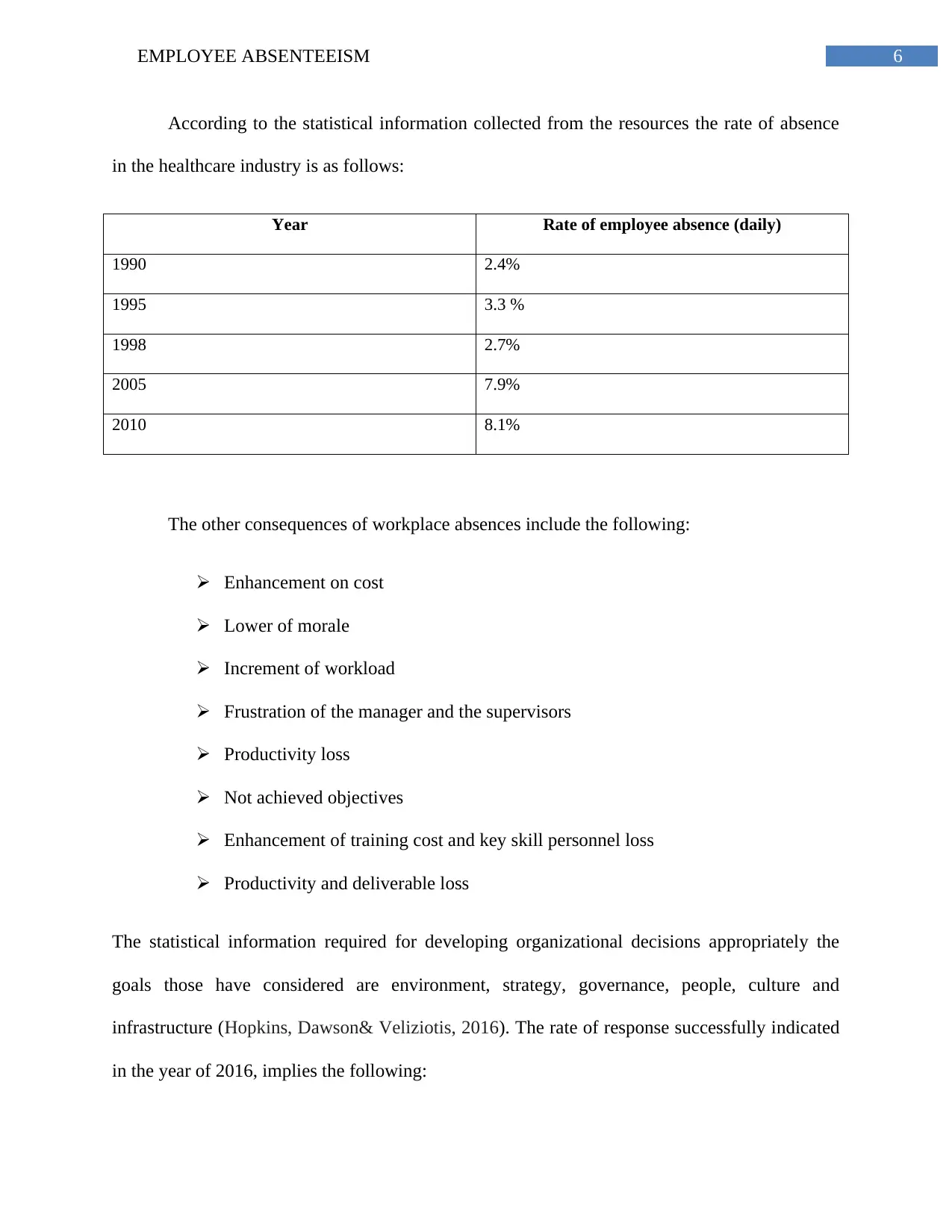
6EMPLOYEE ABSENTEEISM
According to the statistical information collected from the resources the rate of absence
in the healthcare industry is as follows:
Year Rate of employee absence (daily)
1990 2.4%
1995 3.3 %
1998 2.7%
2005 7.9%
2010 8.1%
The other consequences of workplace absences include the following:
Enhancement on cost
Lower of morale
Increment of workload
Frustration of the manager and the supervisors
Productivity loss
Not achieved objectives
Enhancement of training cost and key skill personnel loss
Productivity and deliverable loss
The statistical information required for developing organizational decisions appropriately the
goals those have considered are environment, strategy, governance, people, culture and
infrastructure (Hopkins, Dawson& Veliziotis, 2016). The rate of response successfully indicated
in the year of 2016, implies the following:
According to the statistical information collected from the resources the rate of absence
in the healthcare industry is as follows:
Year Rate of employee absence (daily)
1990 2.4%
1995 3.3 %
1998 2.7%
2005 7.9%
2010 8.1%
The other consequences of workplace absences include the following:
Enhancement on cost
Lower of morale
Increment of workload
Frustration of the manager and the supervisors
Productivity loss
Not achieved objectives
Enhancement of training cost and key skill personnel loss
Productivity and deliverable loss
The statistical information required for developing organizational decisions appropriately the
goals those have considered are environment, strategy, governance, people, culture and
infrastructure (Hopkins, Dawson& Veliziotis, 2016). The rate of response successfully indicated
in the year of 2016, implies the following:
Paraphrase This Document
Need a fresh take? Get an instant paraphrase of this document with our AI Paraphraser
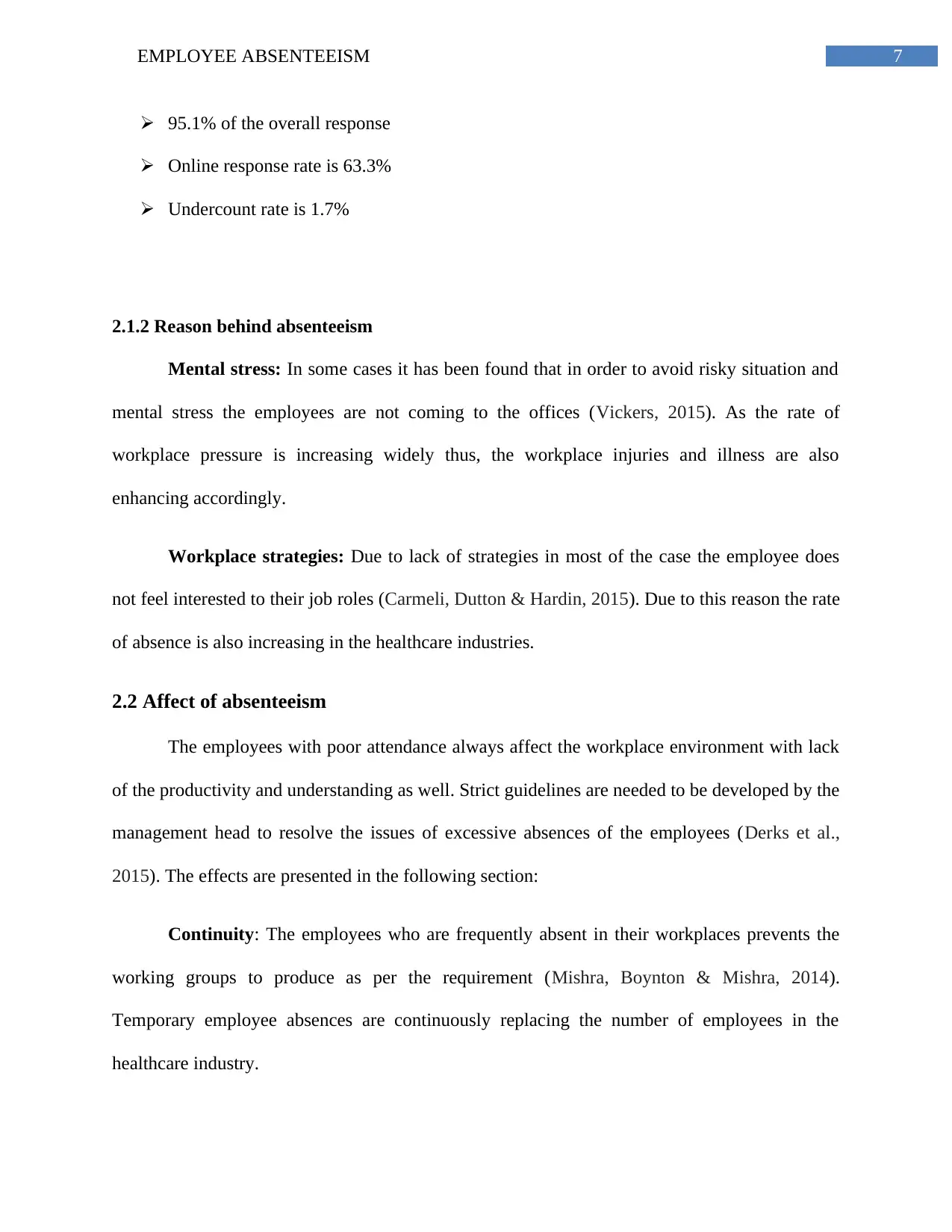
7EMPLOYEE ABSENTEEISM
95.1% of the overall response
Online response rate is 63.3%
Undercount rate is 1.7%
2.1.2 Reason behind absenteeism
Mental stress: In some cases it has been found that in order to avoid risky situation and
mental stress the employees are not coming to the offices (Vickers, 2015). As the rate of
workplace pressure is increasing widely thus, the workplace injuries and illness are also
enhancing accordingly.
Workplace strategies: Due to lack of strategies in most of the case the employee does
not feel interested to their job roles (Carmeli, Dutton & Hardin, 2015). Due to this reason the rate
of absence is also increasing in the healthcare industries.
2.2 Affect of absenteeism
The employees with poor attendance always affect the workplace environment with lack
of the productivity and understanding as well. Strict guidelines are needed to be developed by the
management head to resolve the issues of excessive absences of the employees (Derks et al.,
2015). The effects are presented in the following section:
Continuity: The employees who are frequently absent in their workplaces prevents the
working groups to produce as per the requirement (Mishra, Boynton & Mishra, 2014).
Temporary employee absences are continuously replacing the number of employees in the
healthcare industry.
95.1% of the overall response
Online response rate is 63.3%
Undercount rate is 1.7%
2.1.2 Reason behind absenteeism
Mental stress: In some cases it has been found that in order to avoid risky situation and
mental stress the employees are not coming to the offices (Vickers, 2015). As the rate of
workplace pressure is increasing widely thus, the workplace injuries and illness are also
enhancing accordingly.
Workplace strategies: Due to lack of strategies in most of the case the employee does
not feel interested to their job roles (Carmeli, Dutton & Hardin, 2015). Due to this reason the rate
of absence is also increasing in the healthcare industries.
2.2 Affect of absenteeism
The employees with poor attendance always affect the workplace environment with lack
of the productivity and understanding as well. Strict guidelines are needed to be developed by the
management head to resolve the issues of excessive absences of the employees (Derks et al.,
2015). The effects are presented in the following section:
Continuity: The employees who are frequently absent in their workplaces prevents the
working groups to produce as per the requirement (Mishra, Boynton & Mishra, 2014).
Temporary employee absences are continuously replacing the number of employees in the
healthcare industry.
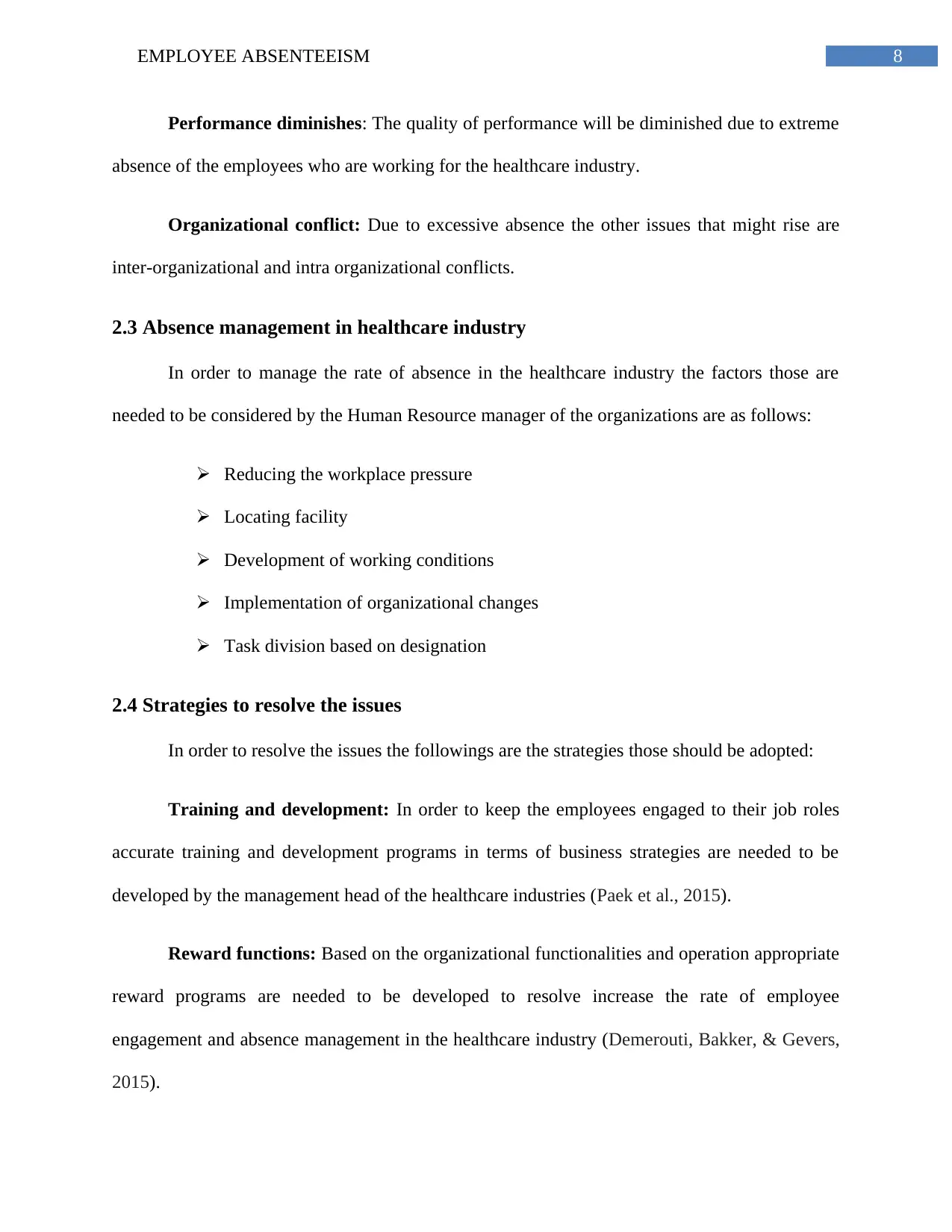
8EMPLOYEE ABSENTEEISM
Performance diminishes: The quality of performance will be diminished due to extreme
absence of the employees who are working for the healthcare industry.
Organizational conflict: Due to excessive absence the other issues that might rise are
inter-organizational and intra organizational conflicts.
2.3 Absence management in healthcare industry
In order to manage the rate of absence in the healthcare industry the factors those are
needed to be considered by the Human Resource manager of the organizations are as follows:
Reducing the workplace pressure
Locating facility
Development of working conditions
Implementation of organizational changes
Task division based on designation
2.4 Strategies to resolve the issues
In order to resolve the issues the followings are the strategies those should be adopted:
Training and development: In order to keep the employees engaged to their job roles
accurate training and development programs in terms of business strategies are needed to be
developed by the management head of the healthcare industries (Paek et al., 2015).
Reward functions: Based on the organizational functionalities and operation appropriate
reward programs are needed to be developed to resolve increase the rate of employee
engagement and absence management in the healthcare industry (Demerouti, Bakker, & Gevers,
2015).
Performance diminishes: The quality of performance will be diminished due to extreme
absence of the employees who are working for the healthcare industry.
Organizational conflict: Due to excessive absence the other issues that might rise are
inter-organizational and intra organizational conflicts.
2.3 Absence management in healthcare industry
In order to manage the rate of absence in the healthcare industry the factors those are
needed to be considered by the Human Resource manager of the organizations are as follows:
Reducing the workplace pressure
Locating facility
Development of working conditions
Implementation of organizational changes
Task division based on designation
2.4 Strategies to resolve the issues
In order to resolve the issues the followings are the strategies those should be adopted:
Training and development: In order to keep the employees engaged to their job roles
accurate training and development programs in terms of business strategies are needed to be
developed by the management head of the healthcare industries (Paek et al., 2015).
Reward functions: Based on the organizational functionalities and operation appropriate
reward programs are needed to be developed to resolve increase the rate of employee
engagement and absence management in the healthcare industry (Demerouti, Bakker, & Gevers,
2015).
⊘ This is a preview!⊘
Do you want full access?
Subscribe today to unlock all pages.

Trusted by 1+ million students worldwide
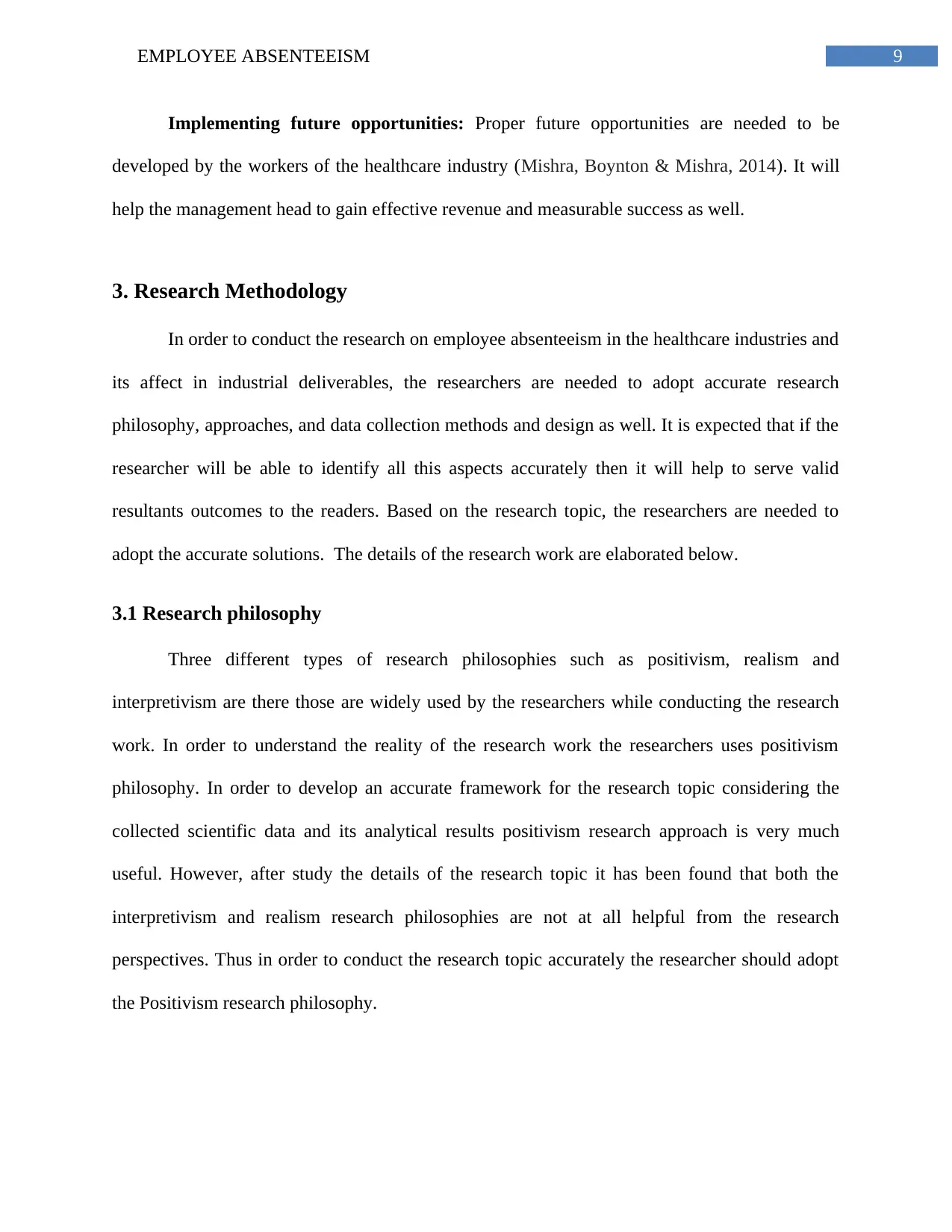
9EMPLOYEE ABSENTEEISM
Implementing future opportunities: Proper future opportunities are needed to be
developed by the workers of the healthcare industry (Mishra, Boynton & Mishra, 2014). It will
help the management head to gain effective revenue and measurable success as well.
3. Research Methodology
In order to conduct the research on employee absenteeism in the healthcare industries and
its affect in industrial deliverables, the researchers are needed to adopt accurate research
philosophy, approaches, and data collection methods and design as well. It is expected that if the
researcher will be able to identify all this aspects accurately then it will help to serve valid
resultants outcomes to the readers. Based on the research topic, the researchers are needed to
adopt the accurate solutions. The details of the research work are elaborated below.
3.1 Research philosophy
Three different types of research philosophies such as positivism, realism and
interpretivism are there those are widely used by the researchers while conducting the research
work. In order to understand the reality of the research work the researchers uses positivism
philosophy. In order to develop an accurate framework for the research topic considering the
collected scientific data and its analytical results positivism research approach is very much
useful. However, after study the details of the research topic it has been found that both the
interpretivism and realism research philosophies are not at all helpful from the research
perspectives. Thus in order to conduct the research topic accurately the researcher should adopt
the Positivism research philosophy.
Implementing future opportunities: Proper future opportunities are needed to be
developed by the workers of the healthcare industry (Mishra, Boynton & Mishra, 2014). It will
help the management head to gain effective revenue and measurable success as well.
3. Research Methodology
In order to conduct the research on employee absenteeism in the healthcare industries and
its affect in industrial deliverables, the researchers are needed to adopt accurate research
philosophy, approaches, and data collection methods and design as well. It is expected that if the
researcher will be able to identify all this aspects accurately then it will help to serve valid
resultants outcomes to the readers. Based on the research topic, the researchers are needed to
adopt the accurate solutions. The details of the research work are elaborated below.
3.1 Research philosophy
Three different types of research philosophies such as positivism, realism and
interpretivism are there those are widely used by the researchers while conducting the research
work. In order to understand the reality of the research work the researchers uses positivism
philosophy. In order to develop an accurate framework for the research topic considering the
collected scientific data and its analytical results positivism research approach is very much
useful. However, after study the details of the research topic it has been found that both the
interpretivism and realism research philosophies are not at all helpful from the research
perspectives. Thus in order to conduct the research topic accurately the researcher should adopt
the Positivism research philosophy.
Paraphrase This Document
Need a fresh take? Get an instant paraphrase of this document with our AI Paraphraser
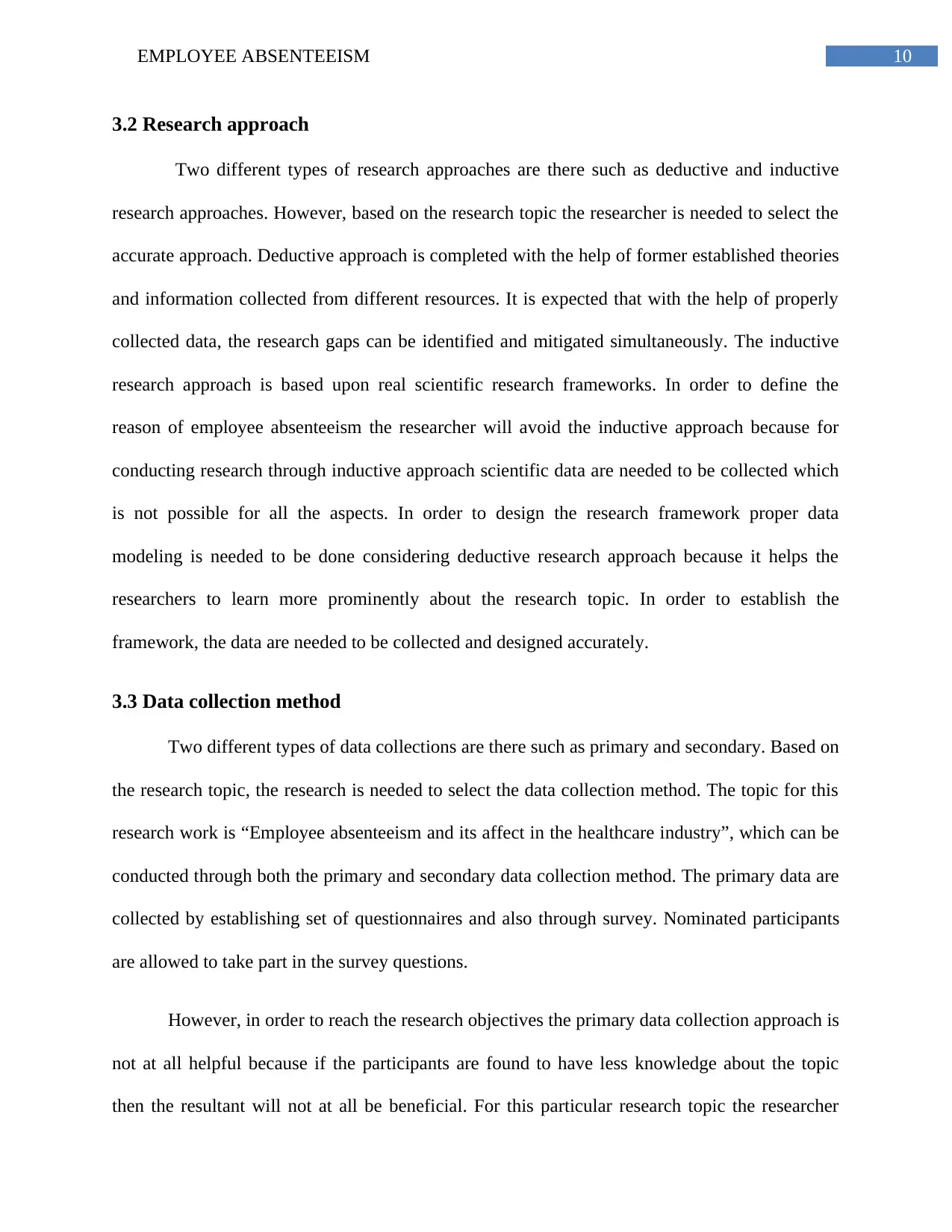
10EMPLOYEE ABSENTEEISM
3.2 Research approach
Two different types of research approaches are there such as deductive and inductive
research approaches. However, based on the research topic the researcher is needed to select the
accurate approach. Deductive approach is completed with the help of former established theories
and information collected from different resources. It is expected that with the help of properly
collected data, the research gaps can be identified and mitigated simultaneously. The inductive
research approach is based upon real scientific research frameworks. In order to define the
reason of employee absenteeism the researcher will avoid the inductive approach because for
conducting research through inductive approach scientific data are needed to be collected which
is not possible for all the aspects. In order to design the research framework proper data
modeling is needed to be done considering deductive research approach because it helps the
researchers to learn more prominently about the research topic. In order to establish the
framework, the data are needed to be collected and designed accurately.
3.3 Data collection method
Two different types of data collections are there such as primary and secondary. Based on
the research topic, the research is needed to select the data collection method. The topic for this
research work is “Employee absenteeism and its affect in the healthcare industry”, which can be
conducted through both the primary and secondary data collection method. The primary data are
collected by establishing set of questionnaires and also through survey. Nominated participants
are allowed to take part in the survey questions.
However, in order to reach the research objectives the primary data collection approach is
not at all helpful because if the participants are found to have less knowledge about the topic
then the resultant will not at all be beneficial. For this particular research topic the researcher
3.2 Research approach
Two different types of research approaches are there such as deductive and inductive
research approaches. However, based on the research topic the researcher is needed to select the
accurate approach. Deductive approach is completed with the help of former established theories
and information collected from different resources. It is expected that with the help of properly
collected data, the research gaps can be identified and mitigated simultaneously. The inductive
research approach is based upon real scientific research frameworks. In order to define the
reason of employee absenteeism the researcher will avoid the inductive approach because for
conducting research through inductive approach scientific data are needed to be collected which
is not possible for all the aspects. In order to design the research framework proper data
modeling is needed to be done considering deductive research approach because it helps the
researchers to learn more prominently about the research topic. In order to establish the
framework, the data are needed to be collected and designed accurately.
3.3 Data collection method
Two different types of data collections are there such as primary and secondary. Based on
the research topic, the research is needed to select the data collection method. The topic for this
research work is “Employee absenteeism and its affect in the healthcare industry”, which can be
conducted through both the primary and secondary data collection method. The primary data are
collected by establishing set of questionnaires and also through survey. Nominated participants
are allowed to take part in the survey questions.
However, in order to reach the research objectives the primary data collection approach is
not at all helpful because if the participants are found to have less knowledge about the topic
then the resultant will not at all be beneficial. For this particular research topic the researcher
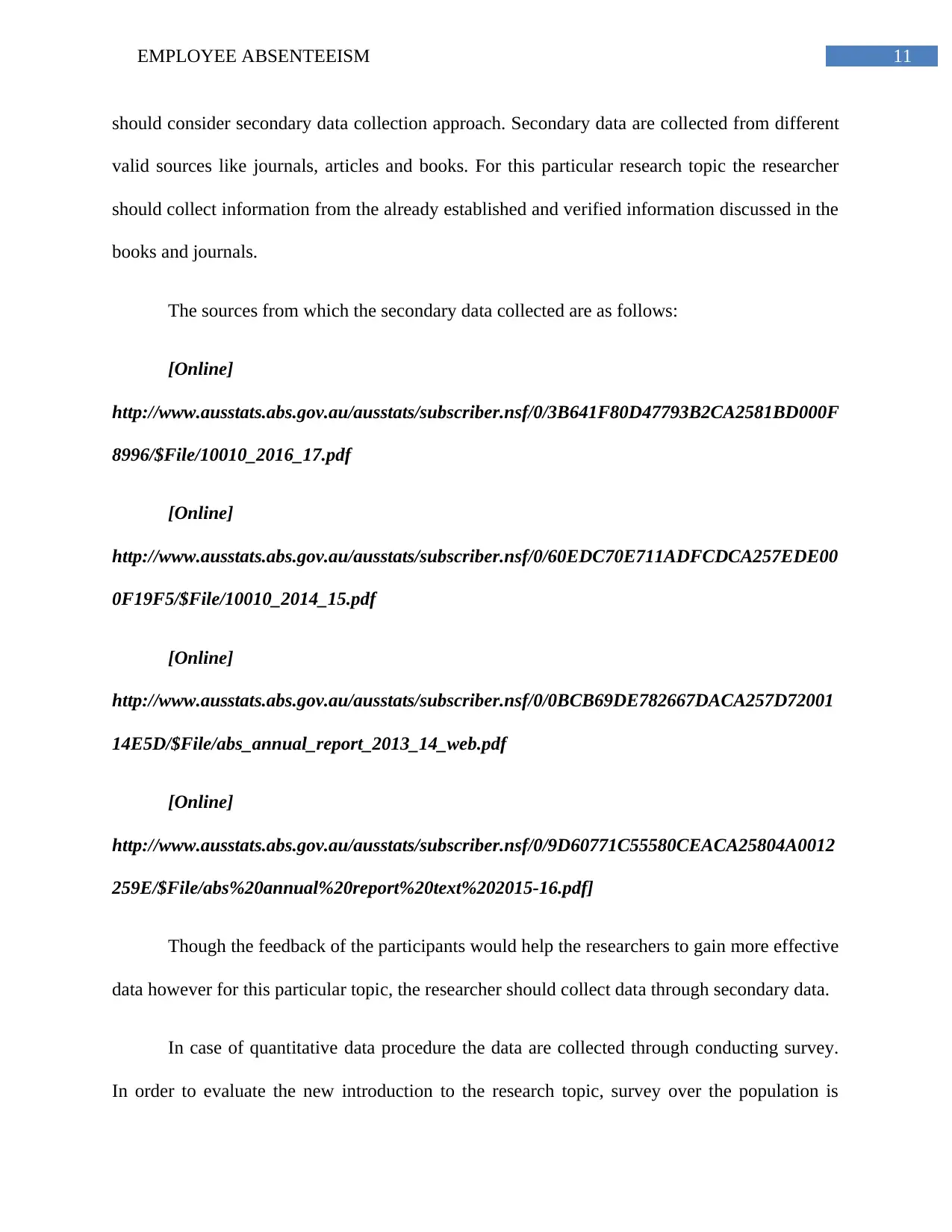
11EMPLOYEE ABSENTEEISM
should consider secondary data collection approach. Secondary data are collected from different
valid sources like journals, articles and books. For this particular research topic the researcher
should collect information from the already established and verified information discussed in the
books and journals.
The sources from which the secondary data collected are as follows:
[Online]
http://www.ausstats.abs.gov.au/ausstats/subscriber.nsf/0/3B641F80D47793B2CA2581BD000F
8996/$File/10010_2016_17.pdf
[Online]
http://www.ausstats.abs.gov.au/ausstats/subscriber.nsf/0/60EDC70E711ADFCDCA257EDE00
0F19F5/$File/10010_2014_15.pdf
[Online]
http://www.ausstats.abs.gov.au/ausstats/subscriber.nsf/0/0BCB69DE782667DACA257D72001
14E5D/$File/abs_annual_report_2013_14_web.pdf
[Online]
http://www.ausstats.abs.gov.au/ausstats/subscriber.nsf/0/9D60771C55580CEACA25804A0012
259E/$File/abs%20annual%20report%20text%202015-16.pdf]
Though the feedback of the participants would help the researchers to gain more effective
data however for this particular topic, the researcher should collect data through secondary data.
In case of quantitative data procedure the data are collected through conducting survey.
In order to evaluate the new introduction to the research topic, survey over the population is
should consider secondary data collection approach. Secondary data are collected from different
valid sources like journals, articles and books. For this particular research topic the researcher
should collect information from the already established and verified information discussed in the
books and journals.
The sources from which the secondary data collected are as follows:
[Online]
http://www.ausstats.abs.gov.au/ausstats/subscriber.nsf/0/3B641F80D47793B2CA2581BD000F
8996/$File/10010_2016_17.pdf
[Online]
http://www.ausstats.abs.gov.au/ausstats/subscriber.nsf/0/60EDC70E711ADFCDCA257EDE00
0F19F5/$File/10010_2014_15.pdf
[Online]
http://www.ausstats.abs.gov.au/ausstats/subscriber.nsf/0/0BCB69DE782667DACA257D72001
14E5D/$File/abs_annual_report_2013_14_web.pdf
[Online]
http://www.ausstats.abs.gov.au/ausstats/subscriber.nsf/0/9D60771C55580CEACA25804A0012
259E/$File/abs%20annual%20report%20text%202015-16.pdf]
Though the feedback of the participants would help the researchers to gain more effective
data however for this particular topic, the researcher should collect data through secondary data.
In case of quantitative data procedure the data are collected through conducting survey.
In order to evaluate the new introduction to the research topic, survey over the population is
⊘ This is a preview!⊘
Do you want full access?
Subscribe today to unlock all pages.

Trusted by 1+ million students worldwide
1 out of 24
Related Documents
Your All-in-One AI-Powered Toolkit for Academic Success.
+13062052269
info@desklib.com
Available 24*7 on WhatsApp / Email
![[object Object]](/_next/static/media/star-bottom.7253800d.svg)
Unlock your academic potential
Copyright © 2020–2025 A2Z Services. All Rights Reserved. Developed and managed by ZUCOL.




